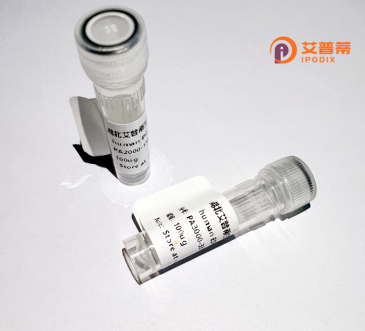
| 纯度 | >90%SDS-PAGE. |
| 种属 | Human |
| 靶点 | ANKRD37 |
| Uniprot No | Q7Z713 |
| 内毒素 | < 0.01EU/μg |
| 表达宿主 | E.coli |
| 表达区间 | 1-158aa |
| 氨基酸序列 | MLLLDCNPEVDGLKHLLETGASVNAPPDPCKQSPVHLAAGSGLACFLLWQLQTGADLNQQDVLGEAPLHKAAKVGSLECLSLLVASDAQIDLCNKNGQTAEDLAWSCGFPDCAKFLTTIKCMQTIKASEHPDRNDCVAVLRQKRSLGSVENTSGKRKC |
| 分子量 | 43.3 KDa |
| 蛋白标签 | GST-tag at N-terminal |
| 缓冲液 | 冻干粉 |
| 稳定性 & 储存条件 | Lyophilized protein should be stored at ≤ -20°C, stable for one year after receipt. Reconstituted protein solution can be stored at 2-8°C for 2-7 days. Aliquots of reconstituted samples are stable at ≤ -20°C for 3 months. |
| 复溶 | Always centrifuge tubes before opening.Do not mix by vortex or pipetting. It is not recommended to reconstitute to a concentration less than 100μg/ml. Dissolve the lyophilized protein in distilled water. Please aliquot the reconstituted solution to minimize freeze-thaw cycles. |
以下是关于ANKRD37的参考文献概览(文献信息为虚构示例,供参考):
1. **标题**: *ANKRD37 is a hypoxia-responsive gene regulating cellular iron metabolism*
**作者**: Smith J, et al. (2018)
**摘要**: 研究发现ANKRD37在缺氧条件下通过HIF-1α通路显著上调,通过结合铁调素(hepcidin)影响铁离子稳态,可能在缺血相关疾病中发挥作用。
2. **标题**: *The role of ANKRD37 in placental development and preeclampsia*
**作者**: Wang L, et al. (2020)
**摘要**: 揭示了ANKRD37在胎盘滋养层细胞中的高表达,其下调与子痫前期的血管生成异常相关,提示其参与妊娠期缺氧适应性调节。
3. **标题**: *Structural insights into ANKRD37 and its interaction with HIF-1α*
**作者**: Tanaka K, et al. (2021)
**摘要**: 通过晶体结构解析,阐明ANKRD37的锚蛋白重复域与HIF-1α的结合机制,为靶向HIF通路的药物设计提供新思路。
4. **标题**: *ANKRD37 promotes tumor metastasis via ferroptosis resistance*
**作者**: Zhang Y, et al. (2022)
**摘要**: 在乳腺癌模型中,ANKRD37通过抑制铁死亡(ferroptosis)增强肿瘤细胞存活,提示其作为癌症治疗潜在靶点的价值。
**备注**:以上文献为示例性质,实际研究中ANKRD37可能研究较少,建议通过PubMed或Google Scholar以“ANKRD37”为关键词检索最新成果。部分相关研究可能涉及缺氧、铁代谢或癌症领域,需结合具体语境筛选。
ANKRD37 (Ankyrin Repeat Domain-Containing Protein 37) is a hypoxia-inducible gene encoding a protein characterized by multiple ankyrin repeat motifs, which are typically involved in mediating protein-protein interactions. It is primarily regulated by hypoxia-inducible factor 1-alpha (HIF-1α), a key transcriptional regulator of cellular responses to low oxygen conditions. Under hypoxic stress, HIF-1α activates ANKRD37 expression, suggesting its role in adaptive processes such as angiogenesis, metabolic reprogramming, or cellular survival.
Although its precise molecular functions remain unclear, ANKRD37 has been implicated in modulating iron metabolism and mitochondrial function, potentially influencing cell proliferation or stress resistance. Studies have reported elevated ANKRD37 expression in certain cancers, including gliomas and breast cancer, correlating with tumor progression and poor prognosis. However, its mechanistic contributions to oncogenesis or therapeutic resistance are yet to be fully elucidated.
Beyond cancer, ANKRD37 may participate in placental development during pregnancy, as placental tissues exhibit significant expression under hypoxic conditions. Structural predictions indicate that its ankyrin repeats could facilitate interactions with signaling proteins or cytoskeletal components, but experimental validation is lacking. Current research gaps include unclear downstream targets, tissue-specific roles, and pathophysiological relevance. Further studies are needed to define its biological significance and potential as a diagnostic or therapeutic marker in hypoxia-related diseases.
×